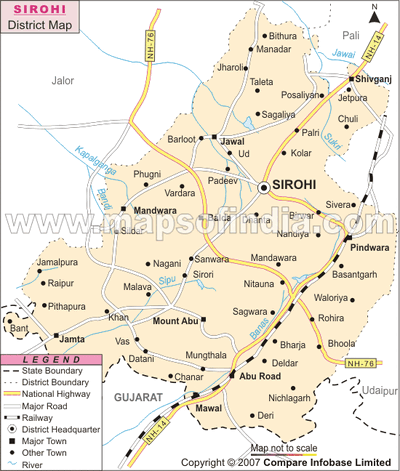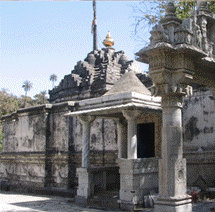Achalgarh
Achalgarh (अचलगढ़) is a fort in Abu Road tahsil of Sirohi district in Rajasthan. Also called Tira[1]/Tirah[2], and it was Parihar capital.
Location
It is situated eleven kilometers north of Mount Abu, a hill station in Sirohi district in Rajasthan, India. It is named after Achala, a name of Shiva. It is known for temples dedicated to Shantinatha, Adinatha and Kunthunatha. [3]
Variants
- Achalgarh (अचलगढ़, राजस्थान) (AS, p.11)
Mention by Panini
Tira (तीर) is mentioned by Panini in Ashtadhyayi. [4]
History
The Parmaras of Malwa were originally from Achalgarh and Chandrawati. Around 810 AD Upendra or Kerishnaraja left the place and established capital in Malwa. They ruled earlier from Achalgarh for a long period. [5]
A large number of inscriptions have been discovered from this place and aroud it. The number of the inscriptions the total number, 148 are from the temple of Rishabha (idinatha) which was founded by Vimala ; 97 from the temple of Neminatha, founded by Tejahpala, 30 from the temple of Achalesvara, and 13 from other localities.
Achalgarh fort, built by Rana Kumbha of Mewar Dynasty during the 14th century temple, is built for watching the movements of enemies and also to have a watch over the surrounding places.
Ram Sarup Joon[6] writes that Jats accepted Gujar leadership because Gujars were Buddhists and had arisen for a noble cause. The Jats who joined the Gujar force also came to be known as Gujars by and by. Kings of Solankhi Gotra,
History of the Jats, End of Page-115
Panwar or Partihars established two kingdoms named Bhinmal, and Tira (Achalgarh) in the area of Mount Abu.
The proof ofParmars and Pratihars being Gujars or Huns is that there was a town named Jablapuri which both these kingdoms claimed as their heritage. Jabila (Hun) was the chief of the tribe.
अचलगढ़
अचलगढ़ राजस्थान: (AS, p.11): विजयेन्द्र कुमार माथुर[7] ने लेख किया है ... आबू के निकट स्थित है. मालवा के परमार राजपूत मूल रूप से अचलगढ़ और चंद्रावती के रहने वाले थे. 810 ई. के लगभग उपेंद्र अथवा कृष्णराज परमार ने इस स्थान को छोड़कर मालवा में पहली बार अपनी राजधानी स्थापित की थी. इससे पहले बहुत समय तक अचलगढ़ में परमारों का निवास स्थान रहा था.
The fort
The fortress Achalgarh is surrounded by massive battlement walls. It is situated at the top of a mountain peak and offers picturesque views all year round. AchalGarh is found at the top of a steep winding path, whereby the 15th century fortresses and the temples are enclosed within the fortified walls.
The fort was built by Maharana Kumbha in 1452 CE, one of the several forts built during his reign. The fort is not in good condition now.
Important places
There are some features of historical and religious importance in and around the fort. These are Jain temples, Achaleswar Mahadev Temple (1412AD) and the Kantinath Temple (1513AD). The Achaleshwar Mahadeo temple is a renowned pilgrim center with the prime deity as Lord Shiva.
Achaleshwar Mahadeva temple :
Achaleshwar Mahadeva temple is just outside the fort; the toe of Lord Shiva is worshipped there and a brass Nandi is also located there. Near the temple there are three stone buffaloes standing around a pond. It is believed that the Achleshwar temple was built in the 9th century and legend has it that it was built around a toe print of Lord Shiva. There is also a pit that is said to reach to the netherworld. Achleshwar also contains a natural Shivalinga. There are also many other sculpted idols which are made of a crystal like stone. In natural light, this stone looks opaque, but if you place a candle behind the idols they take on a beautiful crystal-like sparkle, the stone is called the crystal stone or sfatik in hindi. nearby the temple, we find the scenic looking Mandakini Lake. This lake is surrounded by rocky hills, and rock walls covered with images of a king and buffaloes. These pictures are said to represent the legend that says the lake was filled with ghee and the watering hole of demons disguised as buffaloes. This was until they were shot by Raja Adi Pal.
There are Jain temples in the fort. These were built in 1513 CE.
Achaleshwar temple inscription of year 1377 V.E. (1320 AD)
Lumbha was the founder of the Chauhan Deora rule on Abu. The inscription of his time dated 1377 V.E. (1320)in the Achaleshwar temple says,
- " He acquired the beautiful country round Abu and Chandravati by his own valour."
This was about the year 1368 V.E. (1311) according to the Sirohi badwas, though according to Muta Nainsi, the date of the conquest of Chandravati is 1216 V.E. (1159). In the chronicles of Muta Nainsi and the badwa books he is named Hun. The story of the expulsion of Parmars may be told briefly as follows :—
- " Bagarji was succeeded by his son,Lumbha, in whose time there was constant fighting between the Deoras and the Paramars ; the latter were driven from Chandravati about 1303 and forced to seek shelter on Abu. This place was too strong to be attacked with any hope of success, so Lumbha resorted to stratagem and sent a proposal that the Paramars should bring twelve of their daughters to be married into the Chauhan clan and thus establish a friendship. The story runs that the overture having been accepted, the girls were accompanied to Vareli (or Bareli), a village north-west of Abu, by nearly all the Paramars; the Deoras then fell upon them, massacred the majority and, pursuing the survivors back to Abu, gained possession of the hill."
Three inscriptions of Lumbha's reign have been found on Abu, two in the temple of Vimalsah and the third in the temple of Achaleshwar. The dates of the first two are 1372 and 1373 V.E. (1315 and 1316) and of the third 1377 V.E. (1320). Lumbha had restored the temple of Achaleshwar, installed his own statues and his queen's in it, and endowed a village named Hethumji. His chief minister was Devi-sah. In Sanskrit books he is styled Lunig, Lundhig,Lundhgar, and Lumbha. The Vimalsah temple inscription gives the names of his two sons, Tej Singh and Tehunak. Tej Singh (1377—1393 V.E.). His capital was Chandravati. The following inscriptions of his reign have been found :—
- Inscription in the temple of Vimalsah dated Jyesth S. 9. 1378 V.E. (1321).
- Inscription dated Magh S., 1397 V.E. (1330) in the Achaleshwar temple.
- Inscription dated 1393 V.E. (1336). He endowed three villages, Jakhtun, Jyatul and Tejalpur to the temple of Vasishtha.
Source - Chauhans of Sirohi
Achaleshwar temple inscription of year 1342 V.E. (1285 AD)
डॉ. गोपीनाथ [8] लिखते हैं कि यह शिलालेख अचलेश्वर (आबू) के मंदिर के पास वाले मठ के एक चौपाल के दीवार में लगाया गया था. इसमें 47 पंक्तियाँ हैं. भाषा पद्य में संस्कृत है. इसका समय वि.सं. 1342 माघ शुक्ल १ दिया गया है. इसमें बापा से लेकर समरसिंह के काल की वंशावली दी है. समरसिंह के बारे में लिखा है की उसने यहाँ सुवर्णध्वजधारी मठ का निर्माण कराया और वह यहाँ रहने वाले भावशंकर महात्मा का शिष्य था. प्रस्तुत लेख में मेवाड़ का बड़ा रोचक वर्णन दिया गया है. मेदपाट के सम्बन्ध में प्रशस्तिकार लिखता है क़ि बापा के द्वारा यहाँ दुर्जनों का संहार हुआ और उनकी चर्बी से यहाँ की भूमि गीली हो जाने से इसे मेदपाट कहा गया. नागदा नगर के सम्बन्ध में हारीत ऋषि का वर्णन आता है जिन्होंने यहाँ घोर तपस्या की थी. इन्हीं की अनुकम्पा से बापा को राज्य प्राप्त हुआ और क्षत्रियत्व की प्राप्ती हुई. इसी प्रकार आबू को भी एक तपस्या का स्थान बताकर यहाँ के सौन्दर्य और वन की सम्पति का वर्णन बड़ा रोचक है. इस प्रशस्ति का रचयिता प्रियपटु का पुत्र वेद शर्मा नागर था. इसका लेखक शुभचंद्र और उत्कीर्णकर्ता कर्मसिंह सूत्रधार था.
इसके कुछ पद्यांश इस प्रकार हैं -
- हारीतात्किल बप्पकोअध्रिवलय व्याजेन लेभे मह:
- क्षात्रंधातृनिभाद्वितीर्य मुनये ब्राह्मं स्वसेवाच्छ्लात्
- एते अद्यापि महीभुज क्षितितल तद्व श संभूतय:
- शोभंते सुतरामुपात्तवपुष: क्षात्राहि धर्मा इव ।।11।।
Notes by Wiki editor -
1. हारीत ऋषि - Harita (हरिता) is a village in Hisar tahsil and in district Haryana. It was founded by Nagil Jats who came from Ranthambhor. There is a need to research relation between Harta Rishi and history of Nagil clan.
2. Bappa Rawal - Bappa Rawal (Kalbhoj) (b. Prince Kalbhoj, ca 713-d. 753, at Eklingji), eighth ruler of the Guhilot Dynasty and founder of the Mewar Dynasty. He acquired Kshatriya status by blessings of Harita Rishi at Nagda. His actual name was Prince Kalbhoj who came from Atri clan and did not continue the family name of seven generations when he came to the throne.[9]
See also
References
- ↑ History of the Jats/Chapter VI,p.116
- ↑ History of the Jats/Chapter V,p.96
- ↑ Encyclopaedia of Jainism, Volume-1 By Indo-European Jain Research Foundation p.5505
- ↑ V. S. Agrawala: India as Known to Panini, 1953, p.65
- ↑ Aitihasik Sthanavali by Vijayendra Kumar Mathur, p.11
- ↑ Ram Sarup Joon: History of the Jats/Chapter VI,p.115-116
- ↑ Aitihasik Sthanavali by Vijayendra Kumar Mathur, p.11
- ↑ शर्मा डॉ. गोपीनाथ शर्मा: राजस्थान के इतिहास के स्त्रोत, 1983, पृ. 116
- ↑ http://en.wikipedia.org/wiki/Bappa_Rawal
Back to Jat Villages

